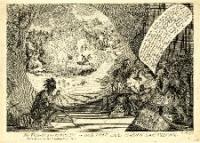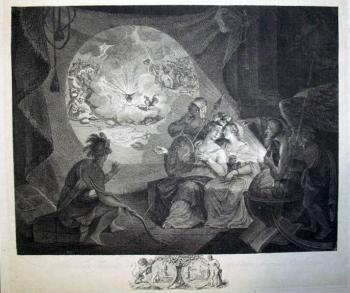

In this 41 x 49 cm. engraving, the winged figure of Father Time is seen balancing a magic lantern on a globe of the world. The image being projected has at its center a steaming tea pot (the American Revolution), cooking on a fire fanned by a cock (symbolizing France), with British soldiers on one side and American soldiers on the other. Time is explaining the scene to four viewers, who represent America, Africa, Europe, and Asia.
Guttenberg was not the original artist of this scene but only adapted it from a 1774 print by John Dixon, shown at the left. Dixon’s print, entitled The Oracle, was suppose to portray a hopeful view of Great Britain at a time when not only America but Scotland and Ireland were threatening revolt. Guttenberg literally reverses the image and replaces the pastoral scene with one of impending war.
Not to be undone by the German artist, an unidentified British caricaturist redrew the print once more in 1783 and put words into Father Time’s mouth:
There you see the little Hot Spit Fire Tea pot that has done all the Mischief - There you see the Old British Lion basking before the American Bon Fire whilst the French Cock is blowing up a storm about his Ears to Destroy him and his young Welpes - There you See Miss America grasping at the Cap of Liberty - There you see The British Forces be yok’d and be cramp’d flying before the Congress Men - There you see the thirteen Stripes and Rattle-Snake exalted - There you see the Stamp’d Paper help to make the Pot Boil -There you See &c &c &c.
Some copies of Guttenberg’s print include the title engraved in English, French, and German. Princeton’s impression has only the English.
